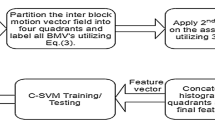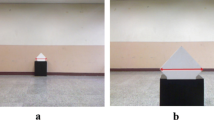Abstract
This paper explores the application of the concept of CURL borrowed from vector calculus to the zoom motion detection and classification problems. The interframe block motion vectors extracted from the compressed bitstream form the input to the proposed method. These block motion vectors are analyzed by partitioning the motion vector field into 4 representative quadrants followed by quantizing the block motion vectors into 3 levels and converting the block motion vectors into complex motion vector space. The resultant vector for each of the 4 quadrants is estimated followed by estimating the velocity vector between the quadrants. The CURL of the velocity field is then estimated whose magnitude essentially provides the area enclosed between the resultant quadrant motion vectors which are utilized for separating the zooming and non-zooming camera types. The zooming camera frames are further classified into zoom-in and zoom-out types utilizing the direction information (anti-clockwise/clockwise) extracted from CURL of the velocity field. The novelty here stems from the fact that a concept borrowed from vector calculus is being applied to the zoom motion analysis problem. Although handcrafted features from CURL are utilized we demonstrate its superiority over existing methods including a deep learning architecture where we show the robustness of the proposed features extracted from CURL in the presence of noise. Experimental validation carried out utilizing block motion vectors extracted using Exhaustive Search Motion Estimation algorithm as well as H.264 decoded block motion vectors demonstrate superior performance for the proposed method both in terms of detection accuracy as well as computational complexity in comparison to existing techniques.









Similar content being viewed by others
References
Abdollahian G, Pizlo Z, Delp EJ (2008) A study on the effect of camera motion on human visual attention. In: 15th IEEE international conference on image processing, pp 693–696
Chang C-C, Lin C-J (2011) LIBSVM: A library for support vector machines. ACM Trans Intell Syst Technol, 2:27:1–27:27. Software available at http://www.csie.ntu.edu.tw/cjlin/libsvm
Chen YM, Bajic IV (2010) Motion vector outlier rejection cascade for global motion estimation. IEEE Signal Process Lett 17(2):197–200
Deng Y, Manjunath BS (1997) Content-based search of video using color, texture, and motion. In: Proceedings of international conference on image processing, vol 2. pp 534–537, vol.2
Duan L-Y, Jin JS, Tian Q, Xu C-S (2006) Nonparametric motion characterization for robust classification of camera motion patterns. IEEE Trans Multimed 8(2):323–340
Fang Y, Lin W, Chen Z, Tsai C, Lin C (2014) A video saliency detection model in compressed domain. IEEE Trans Circuits Syst Video Technol 24 (1):27–38
Ghosh S, Biswas J (2017) Joint perception and planning for efficient obstacle avoidance using stereo vision. In: IEEE/RSJ International conference on intelligent robots and systems (IROS), pp 1026–1031
Guironnet M, Pellerin D, Rombaut M (2006) Camera motion classification based on transferable belief model. In: 14Th european signal processing conference, pp 1–5
Hasan MA, Xu M, He X, Xu C (2014) Camhid: Camera motion histogram descriptor and its application to cinematographic shot classification. IEEE Trans Circuits Syst Video Technol 24(10):1682–1695
Jin R, Qi Y, Hauptmann A (2002) A probabilistic model for camera zoom detection. In: 16Th IEEE international conference on pattern recognition, vol 3. IEEE, pp 859–862
Kesana V, Okade M (2019) Compressed domain zoom motion classification using local tetra patterns. Signal Image and Video Processing 13(5):879–885
Kilicarslan M, Zheng JY (2019) Predict vehicle collision by ttc from motion using a single video camera. IEEE Trans Intell Transp Syst 20(2):522–533
Kreyszig E (2000) Advanced Engineering Mathematics, 8th edn. Wiley, New York
Krizhevsky A, Sutskever I, Hinton GE (2012) Imagenet classification with deep convolutional neural networks. In: Advances in neural information processing systems 25, pp 1097–1105
Luo J, Papin C, Costello K (2009) Towards extracting semantically meaningful key frames from personal video clips: From humans to computers. IEEE Trans Circuits Syst Video Technol 19(2):289–301
Murala S, Maheshwari RP, Balasubramanian R (2012) Local tetra patterns: a new feature descriptor for content-based image retrieval. IEEE Trans Image Process 21(5):2874–2886
Nakaya Y, Harashima H (1994) Motion compensation based on spatial transformations. IEEE Transactions on Circuits and Systems for Video Technology 4(3):339–356, 366–7
Okade M, Patel G, Kumar Biswas P (2016) Robust learning-based camera motion characterization scheme with applications to video stabilization. IEEE Trans Circuits Syst Video Technol 26(3):453–466
Po L-M, Wong K-M, Cheung K-W, Ng K-H (2010) Subsampled block-matching for zoom motion compensated prediction. IEEE Trans Circuits Syst Video Technol 20(11):1625–1637
Sandula P, Okade M (2019) Camera zoom detection and classification based on application of histogram intersection and kullback leibler divergence. In: 2019 National conference on communications (NCC), pp 1–6
Sandula P, Okade M (2019) Camera zoom detection in the compressed domain. In: International conference on range technology, (ICORT), pp 1–4
Schoeffmann K, Taschwer M, Boeszoermenyi L (2009) Video browsing using motion visualization. In: IEEE International conference on multimedia and expo, pp 1835–1836
The H.264 AVC JM Reference Software
Wiegand T, Sullivan GJ, Bjontegaard G, Luthra A (2003) Overview of the h.264/avc video coding standard. IEEE Trans Circuits Syst Video Technol 13(7):560–576
Yuan H, Chang Y, Lu Z, Ma Y (2010) Model based motion vector predictor for zoom motion. IEEE Signal Process Lett 17(9):787–790
Zhang Z, Jing T, Ding B, Gao M, Li X (2019) A model-based approach of foreground region of interest detection for video codecs. Appl Sci 9:2670, 06
Funding
This research work is supported by SERB, Government of India under grant No ECR/2016/ 000112.
Author information
Authors and Affiliations
Corresponding author
Ethics declarations
Conflict of Interests
The authors have no conflicts of interest to declare that are relevant to the content of this article.
Additional information
Publisher’s note
Springer Nature remains neutral with regard to jurisdictional claims in published maps and institutional affiliations.
Rights and permissions
About this article
Cite this article
Sandula, P., Okade, M. Compressed domain video zoom motion analysis utilizing CURL. Multimed Tools Appl 81, 12759–12776 (2022). https://doi.org/10.1007/s11042-022-12363-8
Received:
Revised:
Accepted:
Published:
Issue Date:
DOI: https://doi.org/10.1007/s11042-022-12363-8




